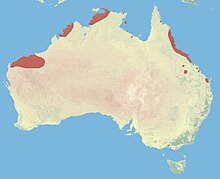Northern quoll
| Northern quoll | |
|---|---|
 |
|
| In Queensland, Australia | |
| Scientific classification | |
| Kingdom: | Animalia |
| Phylum: | Chordata |
| Class: | Mammalia |
| Infraclass: | Marsupialia |
| Order: | Dasyuromorphia |
| Family: | Dasyuridae |
| Genus: | Dasyurus |
| Species: | D. hallucatus |
| Binomial name | |
|
Dasyurus hallucatus Gould, 1842 |
|
 |
|
| Northern quoll range | |
The northern quoll (Dasyurus hallucatus), also known as the northern native cat, the satanellus, the North Australian native cat or the njanmak (in the indigenous Mayali language), is a carnivorous marsupial native to Australia.
The northern quoll is a member of the family Dasyuridae, and is often stated to be the most distinctive Australian quoll. It was first described in 1842 by naturalist and author John Gould, who gave it the species name hallucatus, which indicates it has a notable first digit. This species has sometimes been placed in a separate genus, Satanellus.
The northern quoll is the smallest of the four Australian quoll species. Females are smaller than males, with adult females weighing between 350 and 690 g and adult males 540 and 1120 g. Head and body length ranges from 270–370 mm (adult males) to 249–310 mm (adult females). Tail length ranges between 202 and 345 mm.
Northern quolls feed primarily on invertebrates, but also consume fleshy fruit (particularly figs), and a wide range of vertebrates, including small mammals, birds, lizards, snakes, and frogs. They also scavenge on road-kills, around campsites, and in garbage tins.
A remarkable feature of this species is that the males show complete die-off after mating, leaving the females to raise the young alone. Females have eight teats in a pouch, but apparently give birth to more than eight young which must wriggle their way to the pouch and compete for a teat to survive. In a study in Western Australia's Kimberley region, the testosterone levels of males peaked in July, and females gave birth in July or August.
In the wild, males live for about one year, while the maximum recorded for a wild female was about three years of age. In rocky habitats, the lifespan of both sexes appears to be increased to two or three years, and individuals are larger than those living in savanna habitats, possibly due to better habitat and reduced predation.
The northern quoll occurs from the Pilbara region of Western Australia across the Northern Territory to south east Queensland. Their historical range extended uninterrupted from S.E Queensland to the Kimberleys in Western Australia. There are several disjunct populations. This quoll species is most abundant in rocky ranges and open eucalypt forest.
...
Wikipedia

